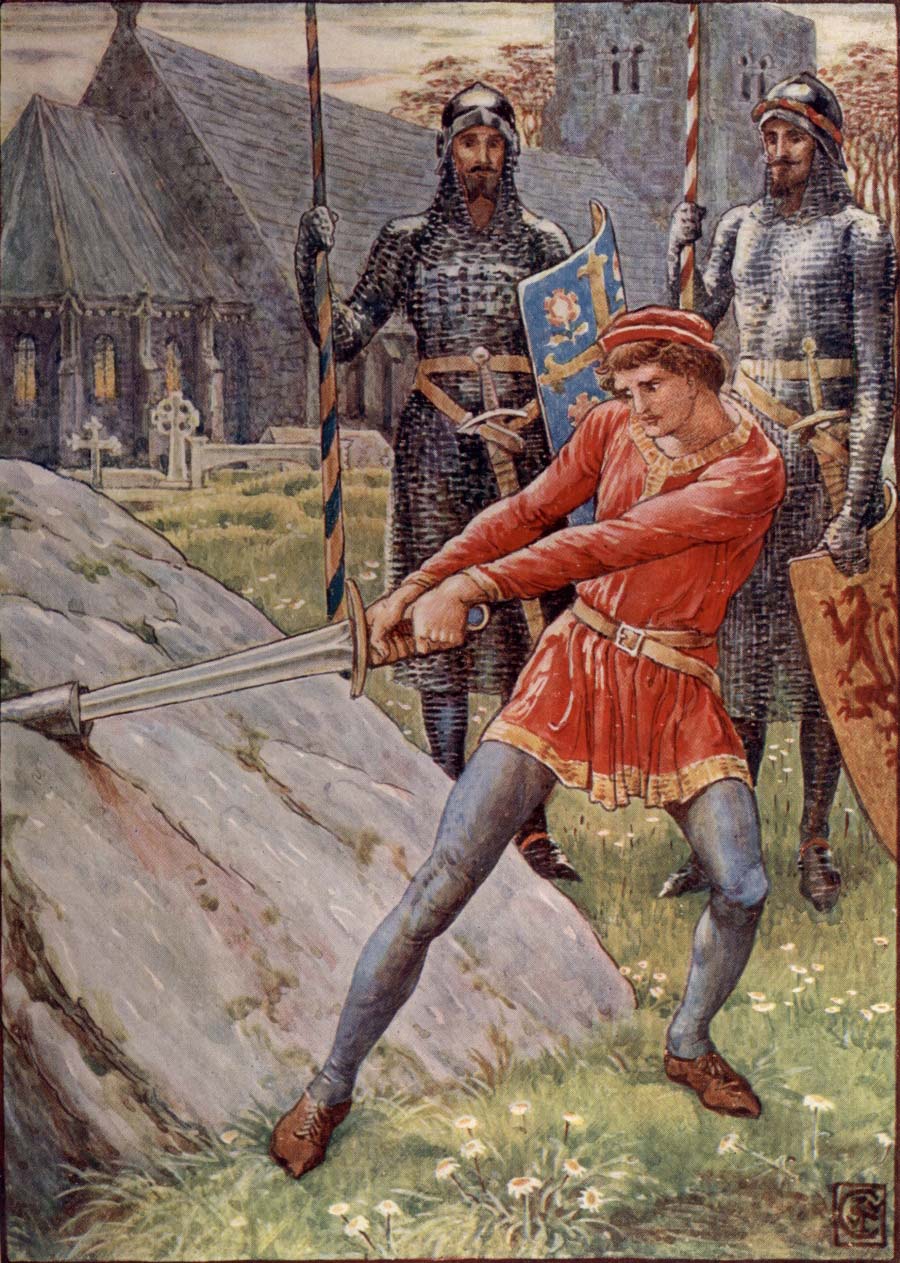Sword
-
Sword
The squire who brought Trebuchet's Sword to the Fisher King, along with the message that the Fisher King's niece had sent it and that she would be greatly pleased if it were passed along to a suitable champion who would use it well, strikes me as a responsible enough character to merit individual inclusion here. In a sense, his errand can be said to herald the Grail procession. I am not sure whose squire he was, the Fisher King's or the niece's, but he was quite well informed.
-
Sword Bridge
le Passage de l'Espee, le Pont de l'EspeeThe more perilous of the two bridges into Gore, it was like a sharp sword. [More]
-
Sword in the Stone
One of the most famous elements of the Arthurian legend, the Sword in the Stone theme first appears in the prose redactions of Robert de Boron’s Merlin.
King Uther Pendragon having died, apparently without an heir, the British lords gathered in Logres or London at the behest of the Archbishop of Canterbury to discuss the appointment of a new king. As if by magic, an enormous stone appeared in a churchyard. The stone had an anvil on top of it, in which a magnificent sword was embedded.

Sword in the Stone | Artist: Unknown
This sword is identical to Excalibur in the prose versions of Merlin, but is a separate sword in the Post-Vulgate Suite du Merlin and in Malory. A message on the pommel of the sword read:
Whoso pulleth this sword out of this stone and anvil is rightfully-born king of all England.
All knights present tried in vain to drawn the sword but it remained fixed in the stone despite their best efforts. Arthur arrived in Logres as the squire of Kay, his foster-brother, who was attending his first tournament. Kay forgot his own sword at the first joust, and sent Arthur to retrieve it. Arthur, unable to find it, wandered into the churchyard and found the Sword in the Stone. With the intention of taking it as a substitute for Kay’s sword, Arthur drew it from the stone, unwittingly proving himself king of Britain. He had to repeat the feat several times to satisfy the lords present. In the versions in which the Sword in the Stone is not Excalibur, Arthur wields it for a while but breaks it during a combat with King Pellinore.

Arthur draws the sword in the stone | Artist: Walter Crane
Another Sword in the Stone appears during the Grail Quest. This sword was called the Adventurous Sword. It had once belonged to Sir Balin the Savage, having been given to him by a lady from Avalon. After Balin’s death, Merlin fitted it with a new pommel, shoved it into a block of marble, and floated it away on a river. At the beginning of the Grail Quest, it floated up to Camelot. The pommel read:
Never shall a man take me hence save only he by whose side I ought to hang, and he shall be the best knight of the world.
Lancelot, Gawain, and Perceval all tried to draw the sword without success. Galahad soon arrived and took the weapon, placing it in an empty scabbard he had brought for that purpose. Galahad later disposed of it in favor of the Sword with the Strange Hangings (see below).
The Sword-in-the-Stone motif is a subset of a larger theme which includes any instance of a knight drawing a weapon from a fixture in order to prove his skill or nobility. In Perlesvaus, for instance, Lancelot has to pull a spear from a pillar to survive the Castle of (the) Griffins, and later must pull a bolt from a pillar in Arthur’s hall. In Meriadeuc, Meriadeuc displays his valor by unbuckling a sword from the waist of Lady Lore of Cardigan.
In Robert de Blois’s Beaudous, Beaudous, Gawaine’s son, proves his right to marry Beaute by drawing the sword Honoree from its sheath. Finally, in the Post-Vulgate Suite du Merlin, Balin proves his prowess by drawing a sword from a sheath carried by a lady from Avalon. This theme is prevalent in classical mythology and may ultimately originate in the Greek tale of Thesus, who proved his paternity by removing his father’s sword from under a stone.
-
Sword of Carados
l'Espee CaradosThe sword of Drian the Gay which Carados carried off with Meliant's sweetheart to the Dolorous Tower.
-
Sword of Galahad
l'Espee de GalahadThis is the sword which Galahad draws out of the floating stone. Perceval takes it when Galahad has found that of David (the Sword with the Strange Hangings).
-
Sword of Galehot
Espee qui of GalehotA sword Lancelot sent through Saraide to his cousin Bohort de Gannes (Sir Bors of Gaul).
-
Sword of Resolve
l'Espee Résoudre, l'Espee ResaudeeThe sword with which the seneschal of Argon wounded Joseph in the thigh. Galahad joins the two pieces when he arrives with Bors and Perceval at Corbenic (Carbonek).
-
Sword with the Red Hilt
One of Sir Balin's swords. Merlin sealed in a stone which Sir Galahad finally drew.
-
Sword with the Strange Baldric
or HangingsThe only thing Chrétien tells us about this weapon is that, according to the Loathly Damsel, the knight who rescues the maiden of Montesclaire may win the right to gird it on safely.
-
Sword with/of the Strange Hangings
Epee as Estranges Renges, l'Espee as Estraignes Renges, l'Espee de DavidA magnificent weapon that first appears in Chrétien de Troyes’s Perceval. It was offered as a reward to anyone who could rescue the maiden besieged in the hill below Montesclaire. Gawain assumed the quest, and won the sword in the First Continuation of Perceval. The First Continuation tells us that the Sword had originally belonged to the Jewish patriot Judas Maccabeus. In Raoul de Houdenc’s Meraugis of Portlesguez as well, Gawain embarks on an adventure to obtain the sword on the Island without a Name.
We learn the full story of the weapon in the Vulgate Queste del Saint Graal, in which it assumes the importance of the Grail Sword from the earlier tales. It had once belonged to the biblical King David of Israel and Judah. It was known as the Sword of David. Upon David’s death, it passed to his son King Solomon. The sword was adorned with precious jewels, and the crossguard was made of the ribs of two mythical beasts - the Papagustes and the Cortenans (Ortenax). It rested in a scabbard known as the Memory of Blood, made from Eden’s Tree of Life, and covered with a serpent’s skin. For all its glory, however, its girdle was made only from hemp, crafted by Solomon's wife.
King Solomon placed the sword upon the Ship of Solomon and sailed it out to sea. It was ordained on the pommel of the sword that only the best knight of the world should ever draw it, and many men fell fate to the sword when they tried to draw it themselves. The first was Nascien, who encountered the ship and the sword at the Turning Isle. He drew the sword and used it to slay a giant, for which Nascien was wounded through the thighs by a holy lance, and the sword was broken. King Mordrains later mended the weapon.
On another occasion, some time before Arthur, King Varlan of Wales used it to kill King Lambor of Listenois, the Grail King. This blow was called the Dolorous Stroke, and it turned Wales and Listenois into the Waste Land. Varlan fell dead upon returning the sword to its scabbard. In a third instance, King Pelles, another Grail King, drew the sword and also received a blow through the thighs with a spear. For this he became known as the Maimed King.
Its destined owner, Galahad, found it on the ship during the Grail Quest. Perceval’s sister made a new girdle for the sword out of her own virgin’s hair. R. S. Loomis thought that this exchange symbolized the replacement of the Old Testament with the New Testament (Loomis, Romance, 304). Galahad used it in several battles. Arthur later remarked that the magnificence of Excalibur was second only to the Sword with the Strange Hangings.
According to La Tavola Ritonda, the Sword with the Strange Hangings was left hanging around the statue of Galahad in front of the castle of Leverzep. Hundreds of years later, Charlemagne took it from the statue and renamed it Gioisa. In other tales, its fate goes unmentioned.
See also
Agrestizia | The Legend of King Arthur
Amide | The Legend of King Arthur
-
Sword with the Two Rings
A magic sword that Gawaine needed to exchange with King Wonder for the magic Floating Chessboard. It was in the possession of King Amoren (Amoraen), who gave it to Gawaine on the condition that Gawaine find and bring him the lady Ysabele.
The sword ensured victory for anyone who wielded it.
